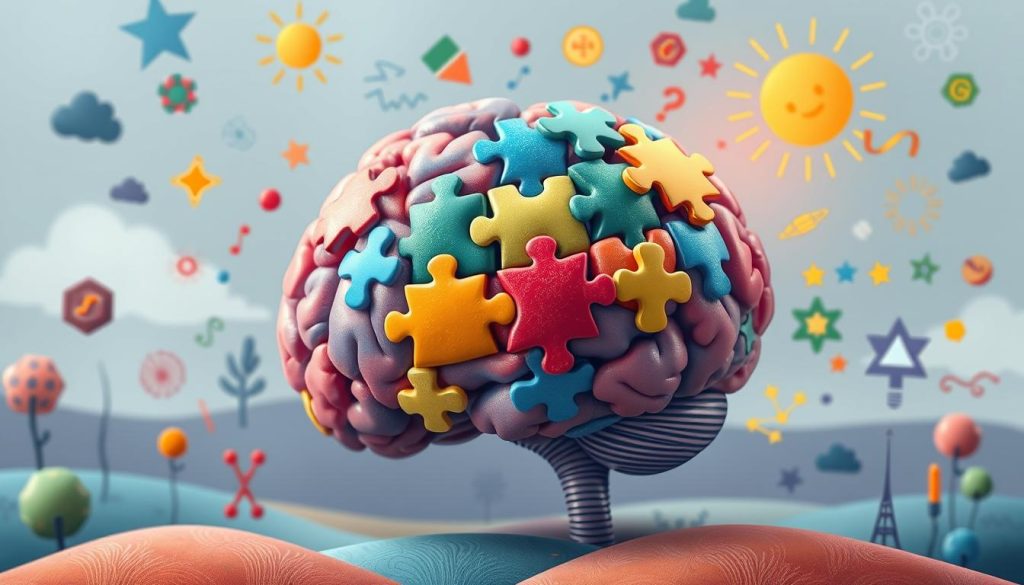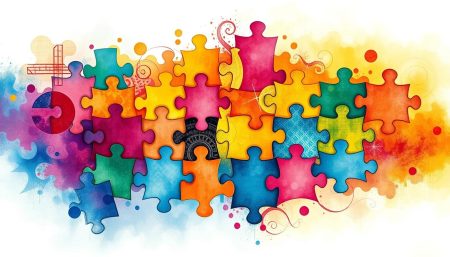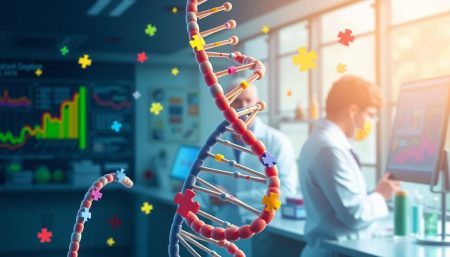Autism Spectrum Disorder (ASD) and Attention-Deficit/Hyperactivity Disorder (ADHD) are often talked about. They are both neurodevelopmental disorders with their own challenges. It’s key for parents, teachers, and health workers to understand them well.
Looking into how ASD and ADHD work together shows a complex relationship. This affects how people see and interact with the world. We’ll focus on the latest research to help us understand these conditions better.
It’s not just about numbers when we talk about autism and ADHD. It’s about the personal stories and the need for more awareness. Let’s dive deep into these topics. We aim to make these conditions clearer and help those affected by sharing knowledge.
Understanding the Overlap Between Autism and ADHD
Autism Spectrum Disorder (ASD) and Attention Deficit Hyperactivity Disorder (ADHD) are complex neurodevelopmental disorders. They present challenges in diagnosis and treatment. It’s important to understand the shared and unique symptoms and the diagnostic hurdles clinicians face.
Commonalities and Distinctions in Symptoms
Both ASD and ADHD affect behavior, communication, and social interactions. Yet, they show these traits in different ways. A common symptom is trouble focusing. But, how and when this happens differs.
In ADHD, trouble focusing is widespread and not just in social situations. In autism, it often relates to social communication.
| Symptom | Autism | ADHD |
|---|---|---|
| Social Interaction | Challenges in social cues and reciprocity | Impulsivity affecting social relations |
| Communication | Delayed speech development; echolalia | Excessive talking without conversational cues |
| Behavioral | Ritualistic behaviors; resistance to change | Hyperactivity; inability to sit |
Diagnostic Challenges in Identifying Dual Diagnoses
Diagnosing both ASD and ADHD together is complex. It requires a deep understanding of each disorder’s criteria. The symptoms of both disorders can be similar, making diagnosis tricky.
For example, trouble focusing and impulsivity can fit into both categories. This makes treatment planning more complex and requires detailed assessments.
Exploring the Causes of Autism Spectrum Disorder and ADHD
Understanding the causes of neurodevelopmental disorders like Autism Spectrum Disorder (ASD) and Attention-Deficit/Hyperactivity Disorder (ADHD) is key. It helps us create better treatments and support systems. Studies show that genetics and environmental factors are both important.
Genetics play a big role in ASD and ADHD. Family and twin studies show that these disorders can run in families. But, scientists are working hard to find out which genes are involved.
Environmental factors also have a big impact. Things like toxins before birth, early birth, and diet after birth can affect brain development. These changes can lead to the symptoms seen in ASD and ADHD.
- Genetic Studies: Ongoing research into genetic mutations and links to neurodevelopmental disorders.
- Environmental Research: Investigations into how pre and postnatal environments modify neurodevelopmental outcomes.
By combining genetic and environmental studies, we get a clearer picture of these disorders. This understanding is vital for creating effective treatments. It helps us address both the genetic and environmental parts of ASD and ADHD.
Even with progress, there’s more to learn about ASD and ADHD. The mix of genetics and environmental factors needs more research. This research helps us improve care and support for those affected and their families.
The Impact of Neurodevelopmental Disorders on Daily Life
Neurodevelopmental disorders like Autism Spectrum Disorder (ASD) and Attention Deficit Hyperactivity Disorder (ADHD) change daily life a lot. They affect how people interact socially and face educational hurdles. It’s key to see how these disorders impact both personal and school life.
Effect on Social Interactions
People with neurodevelopmental disorders find social situations hard. They might struggle to understand social clues, talk like others, and make friends. These issues start early and affect their social and emotional growth.
Parents and teachers see kids with these disorders avoiding eye contact or not getting social cues. This can make them feel left out and hurt their social and emotional skills. They need special help to improve their social abilities.
Challenges in Educational Settings
Students with neurodevelopmental disorders face many challenges in school. They might have trouble focusing, following directions, or behave in ways that disrupt class. This affects not just them but their classmates too.
Schools try to help by creating special plans for each student. These plans, called IEPs, are made to meet their specific needs. They might include different teaching methods, technology help, and extra time in a resource room.
It’s clear that disorders like ASD and ADHD need a lot of focus, mainly in social and school settings. This is where their effects are most noticeable.
Autism Spectrum Disorder and ADHD Diagnosis Process
The diagnosis process for Autism Spectrum Disorder (ASD) and Attention Deficit Hyperactivity Disorder (ADHD) is detailed and multi-faceted. It involves a series of steps guided by validated diagnostic criteria. Understanding these steps is key for early intervention and managing these neurodevelopmental disorders.
The process begins with a detailed developmental history and parental report. Then, healthcare professionals conduct observations and screenings. ASD requires a thorough assessment, including behavioral, cognitive, and language evaluations.
| Steps in Diagnosis | ASD | ADHD |
|---|
Initial ScreeningDevelopmental screening testsParent and Teacher reports, ADHD rating scalesDetailed EvaluationBehavioral assessment, Cognitive testingPsychological evaluation, Rule out other conditionsFollow-Up and MonitoringContinuous developmental monitoringRegular behavioral assessments
For both disorders, accurate diagnosis involves comparing symptoms against established diagnostic criteria like the DSM-5. It’s vital to consider overlapping symptoms and co-occurring conditions, which can make diagnosis complex.
Early intervention is critical, based on a precise diagnosis. It helps improve developmental outcomes and manage neurodevelopmental disorders. Tailored strategies address the unique challenges of ASD and ADHD.
The commitment to a detailed diagnosis process allows healthcare providers to offer targeted interventions. This leads to better life quality for individuals with these disorders.
Comorbidity: When Autism and ADHD Co-exist
Looking into comorbidity in autism and ADHD shows how complex it can be. When these conditions happen together, it makes treatment harder. It needs a careful plan that fits each person’s needs.
Evaluating Co-occurring Conditions
Checking for both autism and ADHD needs a team effort. Doctors use special tests to see how much each condition affects someone. This helps figure out what each person needs.

Adapting Treatment Strategies
Creating a good treatment plan for both autism and ADHD is key. It combines therapies that help with thinking and behavior. This all-in-one approach is vital for success.
| Condition | Impact | Recommended Treatment Strategy |
|---|---|---|
| Autism Spectrum Disorder | Social and communication challenges | Behavioral therapies, Communication enhancement therapy |
| ADHD | Attention regulation issues | Medication, Cognitive-behavioral therapy |
| Comorbid ASD and ADHD | Combined symptoms of both conditions | Integrated approach combining medication and multiple behavioral therapies |
By tailoring treatments for comorbidity, doctors can better manage symptoms. This approach improves behavior and quality of life for those affected.
Behavioral Symptoms of Autism Spectrum Disorder and ADHD
It’s key to understand the behavioral symptoms of autism spectrum disorder and ADHD. This knowledge helps improve diagnosis and treatment. These disorders show different challenges that need specific therapy.
Autism spectrum disorder and ADHD share some symptoms but are different. Autism often includes trouble with social skills, limited interests, and repetitive actions. ADHD is marked by too much activity, impulsive actions, and trouble focusing.
- Difficulties with communication and social interaction
- Limited attention spans that affect learning and task completion
- Hyperactivity that goes beyond the usual energy levels of children their age
- Engagement in repetitive motions or echoing sounds and phrases
Behavior therapy can help with these issues. It uses positive reinforcement to encourage good behavior. Each therapy plan is made for the person’s specific needs.
Behavior therapy helps improve life quality for those with autism and ADHD. It teaches them to handle daily tasks better and social interactions more easily.
Seeing these symptoms through a professional’s eyes is vital. It helps in creating better treatment and management plans for those with autism and ADHD.
Medical and Behavioral Treatment Options for ADHD and Autism
Exploring treatment options for ADHD and autism, we see the importance of both medication management and behavior therapy. These methods help manage symptoms and improve overall health. They are key for those with these conditions.
Effective medication management is vital. It helps balance brain chemicals, easing ADHD and autism symptoms. Healthcare teams constantly adjust treatments for the best results.
Medication Management
Doctors use various medications to help with ADHD and autism. These include stimulants, non-stimulants, and mood stabilizers. Each patient gets a personalized treatment plan, with careful monitoring for side effects.
Behavior Therapy and Support
Behavior therapy is a key part of treatment. It focuses on changing specific behaviors and improving social skills. Educational programs and therapy strategies also play a big role. Plus, having support resources in communities and schools helps a lot.
| Treatment Type | Focus |
|---|---|
| Pharmacotherapy | Regulating neurochemistry to reduce symptoms |
| Behavioral Interventions | Improving social skills and adaptive behaviors |
| Educational Support | Providing structured learning environments |
| Community Services | Enabling access to support groups and resources |
Combining medical treatments with behavioral strategies helps those with ADHD and autism. This approach improves their abilities and quality of life. It’s important to make these treatment options available and accessible everywhere.
Recognizing the Unique Needs in Autism Spectrum Disorder and ADHD Care
Understanding the unique needs of those with Autism Spectrum Disorder (ASD) and Attention Deficit Hyperactivity Disorder (ADHD) is key. Each person needs a personalized treatment plan. This plan should fit their specific challenges and strengths.
Good care strategies involve working together. Healthcare providers, educators, and family members must collaborate. They work to create a care plan that meets each person’s unique social, emotional, and educational needs.
- Thorough assessment to identify distinct challenges and strengths
- Integration of therapy sessions that focus on behavior and communication skills
- Consistent monitoring and adjustment of treatment plans based on progress and feedback
This tailored approach helps individuals thrive despite their challenges. The table below shows the difference between typical interventions and personalized care for ASD and ADHD:
| Aspect of Care | Typical Intervention | Personalized Approach |
|---|---|---|
| Behavioral Management | Standardized behavior modification protocols | Customized behavior plans based on individual triggers and responses |
| Educational Support | Generic special education services | Individualized education programs that align with specific learning styles and needs |
| Family Involvement | Basic education about disorders | Ongoing support and tailored communication strategies for families |
The aim of these personalized treatment and care programs is to improve life quality. With the right support, many can live fulfilling lives and make meaningful contributions to their communities.
The Role of Early Intervention in Managing Symptoms
Early intervention is key in managing symptoms of neurodevelopmental disorders like Autism Spectrum Disorder (ASD) and Attention Deficit Hyperactivity Disorder (ADHD). By starting early and using the right strategies, caregivers and doctors can help these children a lot. This can greatly improve their development.
Benefits of Timely Diagnosis
Getting a diagnosis early is very important. It helps in managing symptoms of ASD and ADHD. Early recognition means starting treatment sooner. This can prevent more serious problems from happening later.
Intervention Strategies for Infants and Toddlers
Using special strategies for young children can change their future. For kids with ASD and ADHD, things like speech therapy and behavioral therapies are helpful. Also, activities that engage their senses can really help.
- Speech therapy to support communication challenges
- Behavioral therapies to manage harmful behaviors and enhance social skills
- Sensorial activities tailored to individual sensitivities to stimulate cognitive development
These methods help kids learn and adapt better. They make it easier for them to fit in with others.
| Age | Intervention Type | Expected Benefits |
|---|---|---|
| 0-3 Years | Speech Therapy | Improves communication abilities |
| 4-5 Years | Behavioral Therapy | Enhances social interaction, reduces negative behaviors |
| 0-5 Years | Sensorial Activities | Boosts cognitive and sensory processing |
Family and Community Support Resources
For those dealing with Autism Spectrum Disorder (ASD) and Attention Deficit Hyperactivity Disorder (ADHD), finding good support resources is key. It can make life better and help with daily struggles. This part talks about the family support and community resources out there, helping you find what you need.

Building strong coping strategies starts with a good support system. A strong network, with health services, education, and peer support, can really help. Knowing where to find these resources is the first step to getting the support you need.
- National and Local Support Groups: Many groups offer meetings where you can share and learn from others with ASD and ADHD. These groups help with feelings and connect you to more community resources.
- Educational Workshops and Seminars: Going to events about new research and strategies can teach you a lot. It helps parents and caregivers understand and manage both conditions better.
- Online Forums and Social Media Groups: Online, you can meet people from all over. These places offer quick advice and support any time you need it.
Using support resources well means knowing what they offer and how they can help. Being part of these resources builds a strong community. It helps people cope better and feel more resilient, improving their overall well-being.
| Type of Support | Description | Benefits |
|---|---|---|
| Peer Support Groups | Groups of people and families facing similar issues. | Support, advice, and understanding from others. |
| Educational Programs | Workshops and seminars about ASD and ADHD. | More knowledge, better strategies, and condition management. |
| Online Communities | Places online for discussion and support. | Always available support, different views, and help anytime. |
Getting involved with family support and community resources is more than finding quick fixes. It’s about creating a lasting support system that grows with you. Every step towards connecting with these resources brings us closer to a more supportive community.
Navigating Educational Accommodations and Supports
Students with ASD and ADHD need special help to do well in school. They need places where everyone learns together and plans made just for them. This helps them do their best.
Creating Inclusive Classrooms
Inclusive classrooms are places where all students can learn together. They help everyone, not just those with special needs. These classrooms use methods and tools that fit each student’s way of learning.
Individualized Education Programs (IEP)
An IEP is a plan for students with special needs in public schools. It outlines what help and support they will get. It also sets goals and checks on progress to help them succeed.
Teachers, parents, and experts must work together to make these plans work. This way, every student gets the help they need to do well.
By focusing on special help and inclusive classrooms, schools can make learning fair for everyone. This way, all students can reach their full potentials.
Lifestyle and Dietary Considerations for Neurodevelopmental Disorders
Managing neurodevelopmental disorders like Autism Spectrum Disorder (ASD) and Attention Deficit Hyperactivity Disorder (ADHD) requires many strategies. Lifestyle considerations and dietary modifications are key. Knowing how lifestyle choices affect well-being and symptom management is vital.
Using holistic approaches in diet and daily routines can improve things a lot. For example, structured routines and diet planning can cut down on hyperactivity and boost focus in ADHD.
- Regular physical activity
- Consistent sleep schedules
- Stress-reduction techniques
Dietary modifications are also very important. Some foods can make symptoms worse, while others can help. Gluten-free and casein-free diets are often talked about for ASD benefits.
| Dietary Element | Benefits | Considerations |
|---|---|---|
| Omega-3 Fatty Acids | Supports brain development and reduces inflammation | Found in fish, flaxseeds, and walnuts |
| Probiotics | Improves gut health, which is linked to cognitive functions | Incorporate through yogurts and supplements |
| Whole Grains | Provides steady energy and supports digestive health | Choose options like quinoa, brown rice, and oatmeal |
Looking into a holistic weight management approach can help manage weight. This is key for mental and physical health in those with neurodevelopmental challenges. Working with nutritionists for tailored diets can lead to lasting health benefits.
- Engagement with health professionals for personalized diet plans
- Regular monitoring of dietary effects on symptoms
- Adaptation of diets based on individual responses and preferences
Lifestyle considerations and dietary modifications are not just for symptom management. They also improve overall quality of life by promoting better health habits and environments.
Advancements in Research and Understanding of ASD and ADHD
The field of neurodevelopmental disorders is changing fast. Advancements in research have shed new light on Autism Spectrum Disorder (ASD) and Attention Deficit Hyperactivity Disorder (ADHD. Recent studies have uncovered new details. These findings are leading to new ways to treat these conditions.
Recent Studies on Neurodevelopmental Disorders
Recent studies have looked into the genetic and environmental causes of these disorders. They’ve found many risk genes, showing how complex these conditions are. This knowledge helps doctors create treatment plans that fit each person’s needs.
Emerging Trends in Treatment and Care
New trends in treating ASD and ADHD include more personalized and tech-based therapies. For example, cognitive-behavioral therapy (CBT) and mindfulness are being adapted for these conditions. These methods have shown to help manage symptoms and improve daily life.
| Study Focus | Key Findings | Impact on Treatment |
|---|---|---|
| Genomic Advances | Identification of new risk genes | Personalized genetic interventions |
| Behavioral Interventions | Effectiveness of tailored CBT | Improved coping strategies |
| Technological Innovations | Use of apps and virtual reality | Enhanced engagement and learning |
In conclusion, the study of neurodevelopmental disorders is moving forward quickly. This is thanks to new research and the use of technology like apps and virtual reality. This mix of innovation and research is making a big difference in how we treat ASD and ADHD.
Parents’ Perspective: Coping with a Child’s Dual Diagnosis
Parents dealing with a child’s dual diagnosis of Autism Spectrum Disorder (ASD) and Attention Deficit Hyperactivity Disorder (ADHD) face a unique journey. They share the challenges of family life and the need for coping strategies. These strategies help manage neurodevelopmental disorders.
Supporting a child with dual diagnosis changes family dynamics and daily life. Parents manage therapies, school, and healthcare while helping their child grow emotionally and socially.
- Coping Strategies: Families need effective ways to cope. This includes routines, therapy, and talking with schools.
- Education and Support Groups: Support groups offer a place to share and learn. They help families facing similar challenges.
The parents’ perspective shows that family resilience is key. Using the right coping strategies and resources can improve family life. It makes interactions better and more balanced.
Technology and Tools for Supporting Individuals with ASD and ADHD
Advanced technology and specialized tools have changed how people with Autism Spectrum Disorder (ASD) and Attention Deficit Hyperactivity Disorder (ADHD) face daily challenges. These tools, from apps for skill development to assistive devices, are key to independence and learning. They help individuals grow and learn in new ways.
Apps and Software for Skill Development
Many apps are powerful tools for skill development. They help with communication, organization, and learning. These apps are made for people with neurodevelopmental disorders. They are easy to use, fun, and teach new skills well.
Assistive Devices and Accessibility Features
There are also assistive devices with advanced features for daily tasks. These devices have settings that fit each person’s needs and learning style. They make technology more accessible for all.
| Category | Tool/Device | Main Benefit |
|---|---|---|
| Apps | Speech generating applications | Enhances communication abilities |
| Apps | Task organization software | Improves planning and execution of tasks |
| Assistive Devices | Electronic calendars with reminders | Helps manage time and appointments effectively |
| Assistive Devices | Wearable technology supporting sensory integration | Assists in regulating sensory challenges |
The Future of Treatment and Awareness for Autism and ADHD
The care for neurodevelopmental disorders is on the verge of big changes. The future of treatment for Autism Spectrum Disorder (ASD) and Attention Deficit Hyperactivity Disorder (ADHD) will bring new methods and teamwork. We’re seeing new medical and behavioral therapies and a change in how society views these conditions.
Increased awareness of ASD and ADHD is key. It’s leading to more inclusive schools and workplaces. Groups focused on neurodiversity are helping make these changes happen.
New treatments are coming from research into ASD and ADHD’s genetics and brain biology. Personalized medicine, using biomarkers, could match treatments to each person’s needs. Technology is also playing a big role, with new tools and ways to get help.
But the biggest change might be how we see and value people with these conditions. A growing effort to understand and accept their unique views and skills is underway. This shift supports inclusive policies that improve life for those with ASD and ADHD.
Creating spaces that meet their needs helps break down barriers. This opens doors to education, jobs, and community activities. Looking ahead, a team effort, knowledge, and empathy will shape the future of treatment and awareness for ASD and ADHD. This will lead to a society that values diversity.
FAQ
Q: What are Autism Spectrum Disorder and ADHD?
A: Autism Spectrum Disorder (ASD) and Attention-Deficit/Hyperactivity Disorder (ADHD) are both brain disorders. ASD makes it hard to talk and act with others. ADHD causes trouble with staying focused and acting impulsively. Some people have both conditions.
Q: What are the common symptoms of both ASD and ADHD?
A: Both ASD and ADHD can make it hard to interact with others and focus. But, how they show up is different. For ASD, it might be not getting social cues. For ADHD, it could be acting without thinking.
Q: What causes Autism Spectrum Disorder and ADHD?
A: We don’t know for sure what causes ASD and ADHD. But, it’s thought that genes and environment play a part. Things like family history and birth complications might matter.
Q: How do ASD and ADHD affect daily life?
A: ASD and ADHD can really affect daily life. They can make it hard to interact with others and do well in school. People might struggle to stay focused and organized.
Q: How are Autism Spectrum Disorder and ADHD diagnosed?
A: Doctors use special criteria to diagnose ASD and ADHD. They look at how a person acts and talks. They also consider how the symptoms affect daily life.
Q: Can someone have both Autism and ADHD?
A: Yes, it’s possible to have both ASD and ADHD. This is called comorbidity. Treating both conditions together can be more complex because of the similar symptoms.
Q: What behavioral symptoms are associated with ASD and ADHD?
A: ASD can cause repetitive behaviors and a strong interest in certain things. ADHD might make someone have trouble sitting and interrupt others. They might also act without thinking.
Q: What treatment options are available for individuals with ASD and ADHD?
A: There are many ways to treat ASD and ADHD. This includes medicine, therapy, and support groups. The right treatment depends on the person’s needs.
Q: What role does early intervention play in managing ASD and ADHD symptoms?
A: Early help is very important for ASD and ADHD. It can improve social skills and learning. Early intervention includes therapies and educational support.
Q: What educational accommodations are available for individuals with ASD and ADHD?
A: Schools can make special plans for students with ASD and ADHD. This includes IEPs and teaching methods that help. They also try to make classrooms welcoming for everyone.
Q: How can dietary modifications affect those with Neurodevelopmental Disorders?
A: Some people with neurodevelopmental disorders might find help in changing their diet. But, it’s important to talk to a doctor before making big changes.
Q: What recent advancements have been made in understanding ASD and ADHD?
A: We’ve learned a lot more about ASD and ADHD recently. This includes new research on genes and brain imaging. We’re also seeing better ways to help people through therapy and technology.
Q: What support resources are available for families dealing with ASD and ADHD?
A: There are many resources for families with ASD and ADHD. This includes support groups, online forums, and educational workshops. They offer advice, support, and ways to connect with others.
Q: How can technology and tools support individuals with ASD and ADHD?
A: Technology can really help people with ASD and ADHD. It can help with organization, learning, and communication. Devices can also make it easier to navigate daily life.
Q: What is the future outlook for treatment and awareness of ASD and ADHD?
A: The future for treating ASD and ADHD looks bright. We can expect better treatments and more understanding. This includes personalized medicine and support for neurodiversity.
Q: How do parents cope with a child’s dual diagnosis of ASD and ADHD?
A: Parents need to learn about ASD and ADHD to cope. They also need a support network and to work with doctors. Many parents find help through support groups and online forums.


















